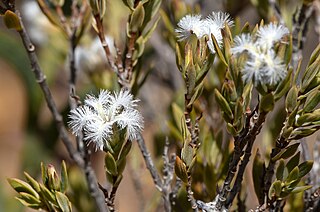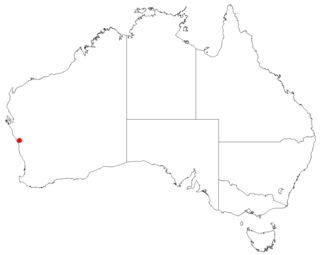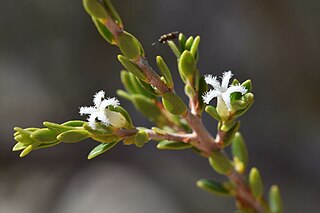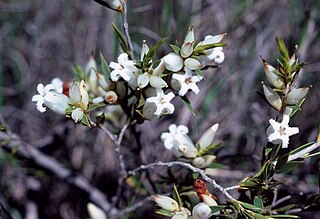
Styphelia planifolia is a species of flowering plant in the heath family Ericaceae and is endemic to the south-west of Western Australia. It is a bushy shrub with narrowly oblong or lance-shaped leaves with a small, sharp point on the tip, and white, tube-shaped flowers.

Leucopogon foliosus is a species of flowering plant in the heath family Ericaceae and is endemic to the south-west of Western Australia. It is a low, spreading shrub with hairy young branchlets, spirally arranged, erect, linear, narrowly egg-shaped to narrowly elliptic leaves, and white, narrowly bell-shaped flowers.

Styphelia stomarrhena is a species of flowering plant in the family Ericaceae and is endemic to the south-west of Western Australia. It is a low, spreading or compact shrub with narrowly elliptic, sharply-pointed leaves and red, tube-shaped flowers usually arranged singly in leaf axils.

Leucopogon inflexus is a species of flowering plant in the heath family Ericaceae and is endemic to the south-west of Western Australia. It is an erect, open shrub with more or less glabrous young branchlets, spirally arranged, erect, egg-shaped to more or less round leaves, and white, bell-shaped, densely bearded flowers.

Leucopogon nitidus is a species of flowering plant in the heath family Ericaceae and is endemic to a small area in Western Australia. It is an erect, open shrub with hairy young branchlets, linear or very narrowly elliptic leaves and erect, compact clusters of 3 to 8 white flowers on the ends of branches and in upper leaf axils.

Leucopogon prolatus is a species of flowering plant in the heath family Ericaceae and is endemic to the south-west of Western Australia. It is an erect, open shrub with a single stem at ground level, egg-shaped to elliptic leaves and erect clusters of 3 to 14 white flowers on the ends of branches and short side-branches.

Styphelia capillaris, commonly known as Horts' styphelia, is a species of flowering plant in the heath family Ericaceae and is endemic to a small area of south-western Western Australia. It is a dense, spreading shrub with narrowly egg-shaped to narrowly elliptic leaves and white flowers arranged singly or in pairs in leaf axils.
Styphelia angustiflora is a species of flowering plant in the heath family Ericaceae and is endemic to a small area near York, in the south-west of Western Australia. It is an erect, compact shrub with sharply-pointed, narrowly egg-shaped leaves and white, tube-shaped flowers.
Styphelia cernua is a species of flowering plant in the heath family Ericaceae and is endemic to a small area of Western Australia. It is an erect shrub with narrowly egg-shaped leaves with the narrower end towards the base, and white flowers arranged singly or in pairs in leaf axils.
Styphelia chlorantha is a species of flowering plant in the heath family Ericaceae and is endemic to a small area of Western Australia. It is a low, spreading shrub with erect, narrowly egg-shaped to egg-shaped leaves with the narrower end towards the base, and green, tube-shaped flowers arranged singly in leaf axils.

Styphelia acervata is a species of flowering plant in the heath family Ericaceae and is endemic to the south-west of Western Australia. It is a dense, prostrate, mat-forming shrub with erect, narrowly egg-shaped leaves, and cream-coloured and greenish tube-shaped flowers.

Styphelia ciliosa is a species of flowering plant in the heath family Ericaceae and is endemic to a small area of Western Australia. It is usually an erect shrub with narrowly elliptic to narrowly egg-shaped leaves with the narrower end towards the base, and white flowers usually arranged in pairs in leaf axils.
Styphelia disjuncta is a species of flowering plant in the heath family Ericaceae and is endemic to a small area in the south-west of Western Australia. It is an erect shrub with egg-shaped to narrowly egg-shaped leaves, and white, tube-shaped flowers arranged singly in leaf axils.
Styphelia filamentosa is a species of flowering plant in the heath family Ericaceae and is endemic to a small area in the south-west of Western Australia. It is a low, compact, spreading shrub with egg-shaped to narrowly elliptic leaves, and white, tube-shaped flowers arranged singly, or in groups of up to four in leaf axils.
Styphelia filifolia is a species of flowering plant in the heath family Ericaceae and is endemic to the south-west of Western Australia. It is an erect shrub with erect, linear leaves, and white, tube-shaped flowers arranged singly, or in groups of up to four in leaf axils.
Styphelia inopinata is a species of flowering plant in the heath family Ericaceae and is endemic to the west of Western Australia. It is a robust, spreading shrub with hairy young branchlets and usually erect, narrowly elliptic, sharply-pointed leaves and reddish pink, very narrowly bell-shaped flowers, usually arranged singly in leaf axils.
Styphelia longissima is a species of flowering plant in the heath family Ericaceae and is endemic to a few places in the south-west of Western Australia. It is an erect shrub with hairy young branchlets, stem-clasping, sharply-pointed, narrowly egg-shaped to narrowly elliptic leaves, and white, tube-shaped flowers.
Styphelia oblongifolia is a species of flowering plant in the heath family Ericaceae and is endemic to the south-west of Western Australia. It is an open or straggling shrub with erect, narrowly oblong leaves and pale yellow, tube-shaped flowers.
Styphelia sulcata is a species of flowering plant in the heath family Ericaceae and is endemic to a small area in the south of Western Australia. It is a low, compact shrub with narrowly egg-shaped leaves and white flowers arranged singly in leaf axils.

Styphelia xerophylla is a species of flowering plant in the heath family Ericaceae and is endemic to the south-west of Western Australia. It is an erect, compact shrub with egg-shaped to narrowly egg-shaped leaves and white, tube-shaped flowers with hairy lobes.











